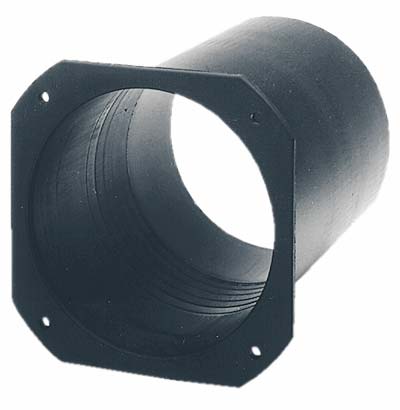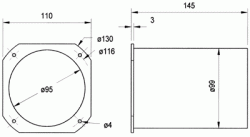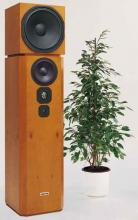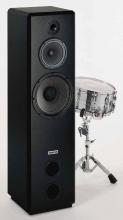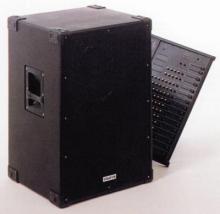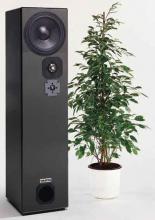Used in / Accessories:
ATLAS COMPACT MK III
Characteristics and sound properties
For those who feel that the ATLAS DSM MK III is just too high and too wide, the ATLAS COMPACT MK III could be just the thing. The aim here was to slim down the size of the cabinets without compromising the excellent sound characteristics of the ATLAS DSM MK III. If you want to cut down the volume of a speaker cabinet without losing too much of the lower bass range, you have to use a bass driver with a smaller diaphragm area. As far as the lower frequency extremes are concerned, the ratio of diaphragm surface area to cabinet volume is of the utmost importance. In this context, the TIW 360 8 Ohm is the ideal bass speaker and the AL 170 8 Ohm optimal as a low- to midrange unit. Of course, a 40 cm subwoofer will generate more bass power than a 30 cm driver simply because it has a larger diaphragm surface area. But the tremendous power generated by the TIW 360 8 Ohm with optimal bass reflex tuning, should easily provide sufficient bass volume for most applications. The use of the same medium and high-range cones as in the ATLAS DSM MK III ensures a close relationship in terms of sound quality with the larger model.
ATLAS DSM MK III
The ATLAS DSM MK III is a superlative column speaker - not only because of its impressive height of 1.70 m, but above all because of its acoustic qualities.
The 5-way combination employs the TIW 400 8 Ohm high-tech speakers as long-stroke woofers, TIW 250 8 Ohm 's as internal drivers, GF 200 2 x 4 Ohm 's as fibre-glass mid-bass units and the tried-and-tested DSM 50 FFL 8 Ohm and DSM 25 FFL 8 Ohm titanium cones as mid- to high-range unit.
After considerably improving the bass range in the MK II version compared with its predecessor by using the TIW 250 8 Ohm as the inner driver, the current model has been further refined as the ATLAS DSM MK III - by including the GF 200 2 x 4 Ohm as the mid-bass unit. The result is far improved pulse dynamics, leading to even more pleasurable listening especially at peak levels.
Let it be said to all owners of the ATLAS DSM MK II, that conversion to the MK III version is remarkable easy. The crossover unit of the MK II has been retained with no change. The GF 200 2 x 4 Ohm can be fitted straight into the cut-out in the baffle of the WS 21 BF and its rim will neatly cover up the existing screw holes.
FIESTA 30
A loudspeaker that produces similar sound characteristics in the hi-fi field as the FIESTA 20, but, due to its higher efficiency rating, can also double up as a speaker for the electronic organ at home and be used in the party room; that is the FIESTA 30.
At the lower end of the frequency scales in this all-round system, we find the tough 12" BG 30 NG 8 Ohm in a generously sized 130-litre vented cabinet. The mid- to high-range is covered by the new BG 20 8 Ohm and the DHT 9 8 Ohm tweeter horn.
The result is a high efficiency rating of 91 dB (1 W/1 m) at impedancelevels that are not amplifier-sensitive and a music load of no less than 250 W.
The robust reproduction quality required for party use or for a musician is complemented adequately by the smooth frequency response with the neutral hi-fi sound qualities required in a home listening environment.
MB 212/H
For sound reproduction in large halls or in the open, you need loudspeakers with a high efficiency rating. This means that the electrical input has to be converted to sound output with the minimum possible loss. Since the mid- and high-range sound is dampened more than the bass sound as the distance from the loudspeaker increases, the frequency response of a speaker designed for this application has to rise as you move up the frequency scale. Otherwise, the speaker will sound dull at a distance.
The MB 212/H musician's P.A. system has the required characteristics and is therefore well suited to use in discos, as an outside small-volume P.A., or as a vocals and instrument speaker. The two powerful 30-cm musician's subwoofers run parallel up to around 4,000 Hz, at which point the robust, but neutral-sounding HTH 8.7 8 Ohm high-range flare takes over.
The following calculation shows how important it is to have the right efficiency rating for professional P.A. speakers: the MB 212/H speaker generates a mean sound pressure of 98 dB at 1 watt and at 1 metre from the speaker. At the maximum permanent load of 300 W, the maximum achievable at 1 metre is 123 dB. In the open, measured at 60 metres from the speaker, the level is merely 87 dB.
Suppose we were to use a normal hi-fi speaker with a high efficiency rating of 90 dB/1 W/1 m, it would take 1,900 watts (!) to achieve 87 dB at a distance of 60 metres. As you can see, no normal hi-fi speaker is in a position to achieve anything like the required compression-free sound output.
VIB EXTRA GF
The VIB EXTRA GF is a 3-way combination in a slim-line, column-like vented cabinet. The design of this cabinet means that a large cabinetvolume (90 litres net) is achieved with relatively little loss of floor space. The woofer is mounted at the top in order to avoid annoying reflections from the floor and sympathetic resonance from the room. The narrow baffle and the asymmetric arrangement of the speaker drivers to one side generate excellent omnidirectional distribution characteristics. The result is good spatial sound output that is to a large extent independent of the listener's seating position. The crossover unit, designed especially for this choice of drivers and this cabinet, separates off the GF 250 2 x 4 Ohmfibre glass woofer at 800 Hz. The titanium mid-range dome speaker is active up to 6 KHz. From here, the DSM 25 FFL 8 Ohm tweeter takes over. The first thing you will notice about the sound produced by the VIB EXTRA GF is the remarkable band-width coverage. The lowest frequencies (20 - 30 Hz) that are not perceived as sound at all but as pressure on the body and ears come across just as readily through the VIB EXTRA GF. This bass reproduction is clear-cut and with good signal fidelity, but makes a smooth impression on the listener, not the gritty sort of bass you would get from musician's PA systems.
In "normal" sized rooms, an incredibly high level of bass is produced in the low frequency range, but not as disco-type bass, which generates most power between 80 and 100 Hz. In other words, the VIB EXTRA GFis precisely what you are looking for if you appreciate real low-range bass but without the boom. If this is still too high, it is possible to adjust certain sections of the port to match it to the room, under certain circumstances.
Are you looking for a bespoke solution?
Contact us